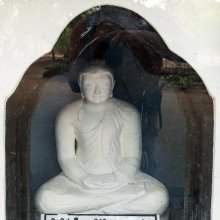Balavan, Balavān: 2 definitions
Introduction:
Balavan means something in Buddhism, Pali, Hinduism, Sanskrit, Marathi. If you want to know the exact meaning, history, etymology or English translation of this term then check out the descriptions on this page. Add your comment or reference to a book if you want to contribute to this summary article.
Images (photo gallery)
In Hinduism
Purana and Itihasa (epic history)
Source: Cologne Digital Sanskrit Dictionaries: The Purana IndexBalavān (बलवान्).—A Saimhikeya.*
- * Vāyu-purāṇa 68. 18.

The Purana (पुराण, purāṇas) refers to Sanskrit literature preserving ancient India’s vast cultural history, including historical legends, religious ceremonies, various arts and sciences. The eighteen mahapuranas total over 400,000 shlokas (metrical couplets) and date to at least several centuries BCE.
In Buddhism
Tibetan Buddhism (Vajrayana or tantric Buddhism)
Source: Wisdom Library: Tibetan BuddhismBalavān (बलवान्) refers to one of the various Grahas and Mahāgrahas mentioned as attending the teachings in the 6th century Mañjuśrīmūlakalpa: one of the largest Kriyā Tantras devoted to Mañjuśrī (the Bodhisattva of wisdom) representing an encyclopedia of knowledge primarily concerned with ritualistic elements in Buddhism. The teachings in this text originate from Mañjuśrī and were taught to and by Buddha Śākyamuni in the presence of a large audience (including Balavān).

Tibetan Buddhism includes schools such as Nyingma, Kadampa, Kagyu and Gelug. Their primary canon of literature is divided in two broad categories: The Kangyur, which consists of Buddha’s words, and the Tengyur, which includes commentaries from various sources. Esotericism and tantra techniques (vajrayāna) are collected indepently.
Languages of India and abroad
Marathi-English dictionary
Source: DDSA: The Aryabhusan school dictionary, Marathi-Englishbalavān (बलवान्).—a balavanta a Strong or powerful.
Marathi is an Indo-European language having over 70 million native speakers people in (predominantly) Maharashtra India. Marathi, like many other Indo-Aryan languages, evolved from early forms of Prakrit, which itself is a subset of Sanskrit, one of the most ancient languages of the world.
See also (Relevant definitions)
Starts with: Balavamda, Balavamtatana, Balavamte, Balavamtike, Balavana, Balavanadere, Balavanem, Balavangi, Balavanita, Balavant, Balavanta, Balavantu.
Ends with: Ampalavan, Cirrampalavan, Nampalavan.
Full-text: Balvan, Balavanta, Balavat, Lokapavada, Tabdha, Samrambhin, Simhasapitha, Smritivirodha, Baladi, Sunanda, Musha, Injate, Yathapi, Uta, Tad.
Relevant text
Search found 21 books and stories containing Balavan, Balavān; (plurals include: Balavans, Balavāns). You can also click to the full overview containing English textual excerpts. Below are direct links for the most relevant articles:
Garga Samhita (English) (by Danavir Goswami)
Verse 4.14.28 < [Chapter 14 - The Story of the Jālandharīs]
Verse 1.6.59 < [Chapter 6 - Description of Kaṃsa’s Strength]
Verse 5.7.43 < [Chapter 7 - The Killing of Kuvalayāpīḍa]
Shrimad Bhagavad-gita (by Narayana Gosvami)
Verse 16.14 < [Chapter 16 - Daivāsura-sampada-yoga]
Women in the Atharva-veda Samhita (by Pranab Jyoti Kalita)
6. Goddess Āsurī < [Chapter 4 - Female Deities and the Glorification of Women in the Atharvaveda]
6b. Hymn to Win the Love of a Husband < [Chapter 2 - The Strīkarmāṇi Hymns of the Atharvaveda]
Bhakti-rasamrta-sindhu (by Śrīla Rūpa Gosvāmī)
Verse 4.5.29 < [Part 5 - Anger (raudra-rasa)]
Verse 3.2.15 < [Part 2 - Affection and Service (dāsya-rasa)]
Rig Veda (translation and commentary) (by H. H. Wilson)
Elephantology and its Ancient Sanskrit Sources (by Geetha N.)
